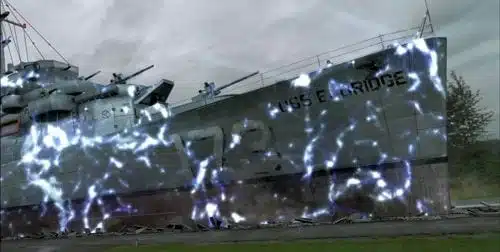
There are so many ways a film can go bad—the acting may be wooden or hammy, the script overly conventional or riddled with improbabilities, the cinematography pedestrian or overly precious. It’s the rare film, however, that manages to combine all these aspects at once. For that achievement, I must give The Philadelphia Experiment my grudging admiration.
The film’s premise is based on a long-standing hoax or urban myth claiming that, during World War II, the U.S. Navy carried out experiments in Philadelphia intended to make a destroyer escort, the U.S.S. Eldridge, undetectable by the enemy. Somehow, the story goes, military scientists hoped to find some way to apply Unified Field Theory to bend light so as to render the ship invisible and/or undetectable by radar—and depending on which version you believe, may have succeeded not only in making this rather formidable ship disappear, but also in causing it to be transported through space from Philadelphia to Norfolk, Virginia, and forward and backward in time.
All this is just about as credible as the supposed UFO that landed at Roswell in 1947, but as the starting point for a science fiction film, it’s perfectly fine (and in fact, it’s already been treated in at least two such films, the 1984 The Philadelphia Experiment and the 1993 Philadelphia Experiment II). Unfortunately, the execution of this premise comes up short in the 2012 The Philadelphia Experiment, which appears to have been made, with apologies to Errol Morris, fast and cheaply, resulting in a film that quickly spins out of control.
It doesn’t start out too badly, particularly for a made-for-TV movie (originally airing on the SyFy channel) directed Paul Ziller, who specializes in such endeavors. The story begins with Dr. Richard Faulkner (Ryan Robbins) gloating to his boss, Kathryn Moore (Gina Holden) that he’s succeeded in developing that superspecial technology he’s been working on. Because she’s such a disdainful bitch, and to prove how much of a badass he is, he demonstrates said technology by making her car disappear.
Ah, but he never thought about the possible unintended consequences. In this case, the electrons stirred up by his little demonstration (accompanied by great quantities of electroplasmic CGI, an effect of which you will quickly tire) also reawakened the slumbering Eldridge, which makes an unexpected appearance on the runway of a remote Pennsylvania airport. One crew member, Bill Gardner (Nicholas Lea) is still alive (and hasn’t aged since the ship disappeared), and by the strangest of coincidences this airport is near his home town, where his granddaughter Molly (Emilie Ullerup) lives and works. She waits tables in a coffee shop, but is also an ace computer hacker, which not only comes in handy later in the film, but might convince the easily persuaded that her character is about something other than long blond hair and really tight jeans.
Unfortunately, things quickly become absurd. Bill and Molly head out to find Morton Salinger (Malcolm McDowell), who led the “real” Philadelphia Experiment in the ’40s, and don’t notice that he’s looking remarkably spry for a guy who, unless he was a regular Doogie Howser, would have to be at least in his 90s by 2012. The evil Richard and Kathryn try to hunt them down, they try to rescue Molly’s fiancé, who has been sucked inside the ship, and there’s lots of fast cuts and CGI to keep you from thinking too hard about anything. I will give the film one thing—it made an attempt at a clever, sentimental ending, although I felt so pummeled by the rapid pace of the illogicalities which came before that it didn’t make much of an impression on me.
For all my criticisms, I have to admit that The Philadelphia Experiment is actually sort of fun to watch, in the way that bad movies sometimes are. It moves so quickly that you don’t have time to get too annoyed at any of its many absurdities, and the actors are certainly easy on the eyes. I do have one piece of advice: if you’re going to develop a drinking game around this film, don’t make a rule about drinking a shot every time you see electroplasma effects on the screen or you’ll be falling under the table before it’s half over. You’ll have more luck raising a toast each time you hear some pseudo-scientific gobbledegook, while if you reserve your shots for the appearance of nonwhite characters, you’ll end the film almost completely sober.
There are absolutely no extras included with The Philadelphia Experiment (honestly, they could at least have put together a little featurette about the supposed historical event and the two previous films), but the visual and audio transfers are fine. The cinematography by Michael C. Blundell has one peculiar aspect—throughout the film, whether a scene takes places indoors or out, the lighting gives everything that radiant look that you sometimes get outdoors just after it rains—but the slight oddness thus created is appropriate for the story.

